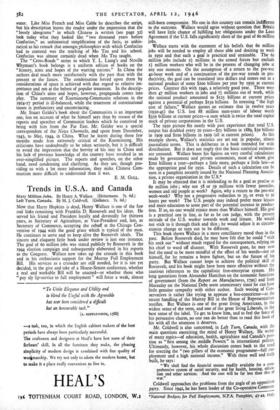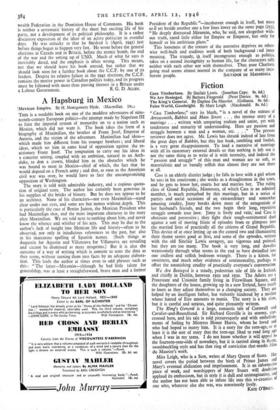Trends in U.S.A. and Canada
Now that Harry Hopkins is dead, Henry Wallace is one of the few real links remaining with Franklin D. Roosevelt and his ideas. He served his friend and President loyally and devotedly for thirteen years, as Secretary of Agriculture, as Vice-President and, last, as Secretary of Commerce, accepting the rebuff at the Chicago Con- vention of 1944 with the good grace which is typical of the man. He continues to serve and to keep alive the Roosevelt ideals. The sincere and eloquent little book under review is just one instance. The goal of 6o million jobs was stated publicly by Roosevelt in the 1944 election campaign and subsequently elaborated in his reports to the Congress. Wallace now takes up the crusade in this book and in his enthusiastic support for the Murray Full Employment Bill. His services as a crusader are still needed, for it is not yet decided, in the give and take of a House-Senate conference, whether a real and workable Bill will be enacted—or whether those who " pay sly lip-service to full employment " will force a weak, almost
still-born compromise. No one in this country can remain indifferent to the outcome. Wallace would agree without question that Britain will have little chance of fulfilling her obligations under the Loan Agreement if the U.S. falls significantly short of the goal of 6o million jobs.
Wallace starts with the statement of his beliefs that 6o million jobs will be needed to employ all those able and desiring to work in 195o and that such a goal is practical and attainable. The 6o million jobs include 2+ millions in the armed forces but exclude if million workers who will be in the process of changing jobs at any one moment. On the assumption of a return to the pre-war 4o-hour week and of a continuation of the pre-war trends in pro- ductivity, the goal can be translated into dollars and comes out as a national product of some $20o billions per year by 195o at current prices. Contrast this with 1940, a relatively good year. There were then 47 million workers in jobs and 7+ millions out of work, while the national product amounted to $125 billions at current prices against a potential of perhaps $15o billions. In stressing " the high cost of failure," Wallace quotes an estimate that in twelve years (1930-41) the U.S. lost 88 million man-years of labour worth $350 billions at current prices—a sum which is twice the total capital stock of private corporations in the U.S.
The 195o picture fits neatly with past experience that total 'U.S. output has doubled every 20 years—$25 billions in 1889, $5o billions
in 1909 and $too billions in 1929 (all at current prices). As this example shows, Wallace's statistics are set out in popular, almost journalistic terms. This is deliberate in a book intended for wide distribution. But it does not imply that the basic statistical estimates are unsound. Wallace bases his figures on very careful calculations made by government and private economists, most of whom give $200 billions a year—perhaps a little more, perhaps a little less—as the appropriate goal for 195o. Details of such a calculation can be seen in a pamphlet recently issued by the National Planning Associa- tion, a private organisation in the U.S.* It may be objected that it is misleading to fix a goal as precise as 6o million jobs ; why not 58 or 59 millions with fewer juveniles, women and old people at work? Again, why a return to the pre-war. work-week? Why not a progressive reduction to 35, or even to 3o hours per week? The U.S. people may indeed prefer more leisure and more education to some part of the potential increase in produc- tion. If so, no one would rejoice more than Wallace himself. His goal is a practical one in line, as far as he can judge, with the present attitude of the U.S. worker towards work and leisure. He would not stick to it through thick and thin ; he would adjust it as circum- stances change or turn out to be different.
This book shows Wallace in a more conciliatory mood than in the past. Before Roosevelt died, he may have felt that he could " stick his neck out " without much regard for the consequences, relying on his chief to ward off disaster. With Roosevelt gone, he may now feel the need to be more mindful of the effect of his words—not on himself, for he remains a brave fighter, but on the future of his party. But Wallace cannot hope to achieve the political skill of Roosevelt, and his book might have been more effective without the cautious references to the capitalistic free-enterprise system. His long quotations from Alexander Hamilton on the economic functions of government (from the Report on Manufactures, 1791) and from Macaulay on the National Debt seem unnecessary since he can have little genuine sympathy with either author. Such wooing of Con- servatives is rather like trying to appease a boa-constrictor—as the recent handling of the Murray Bill in the House of Representatives testifies. But Wallace is one of the great living Americans, in the widest sense of the term, and one of the great living Liberals, in the best sense of the label. To get to know him, and to feel the force of his persuasive charm, no one can do better than to read this book of his with all the attention it deserves.
Mr. Coldwell is also concerned, in Left Turn, Canada, with the main questions exercising the mind of Henry Wallace, He write of many topics—of education, health, agriculture and Canada's posi- tion as " first among the middle Powers " in international politics. Ultimately, however, his whole discussion comes back to the need for erecting the " two pillars of the economic programme—full em- ployment and a high national income." With these well and truly built, he says:
"We shall find the financial means readily available for a com- prehensive system of social security, and for health, housing, educa- tion and other services. And the cost will be far less than that 01 war."
Coldwell approaches the problems from the angle of an opposition party. Since 1942, he has been leader of the Co-operative Common- *National Budgets for Full Employment, N.P.A. Pamphlet, 43-44, 1945. wealth Federation in the Dominion House of Commons. His book is neither a systematic history of the short but exciting life of his party, nor a development of its political philosophy. It is a rather discursive exposition of the ideas of an active politician in eventful days. He was unlucky in that he finished it (April, 1945) just before things began to happen very fast. 'He wrote before the general elections in Canada and in Britain, before the atomic bomb, the end of the war and the setting up of UN O. Much of what he says is i inevitably dated, and the emphasis s often wrong. This means, not that we should leave his book unread, but rather that we should look soon for a further book about the C.C.F. by one of its leaders. Despite its relative failure in the 1945 elections, the C.C.F. remains the motive power in Canadian politics today, and its progress must be followed with more than passing interest in a Britain under



























 Previous page
Previous page